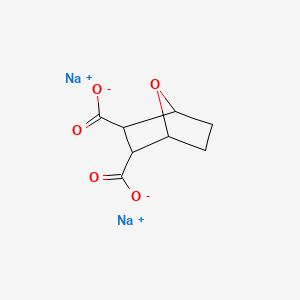



1. Cotazym S
2. Cotazym-s
3. Cotazyme
4. Creon
5. Encron
6. Ilozyme
7. Ku Zyme
8. Ku-zyme
9. Lipram
10. Pancrease
11. Pancrecarb
12. Pancrelipase
13. Pancron
14. Panokase
15. Pertzye
16. Protilase
17. Ultrase
18. Viokase
19. Zymase
1. 13114-29-9
2. Sodium Demethylcantharidate
3. 129-67-9
4. Sodium 7-oxabicyclo[2.2.1]heptane-2,3-dicarboxylate
5. Disodium;7-oxabicyclo[2.2.1]heptane-2,3-dicarboxylate
6. Disodium Endothal
7. Sodium 3-carboxy-7-oxabicyclo[2.2.1]heptane-2-carboxylate
8. Pancrelipase
9. Sodium Norcantharidin
10. Endothall-sodium
11. Sodium-demethylcantharidate
12. 53608-75-6
13. Schembl1006891
14. Dtxsid1041899
15. Chebi:81916
16. Ft-0775390
17. C18724
18. Q27155657
19. Sodium3-carboxy-7-oxabicyclo[2.2.1]heptane-2-carboxylate
| Molecular Weight | 230.13 g/mol |
|---|---|
| Molecular Formula | C8H8Na2O5 |
| Hydrogen Bond Donor Count | 0 |
| Hydrogen Bond Acceptor Count | 5 |
| Rotatable Bond Count | 0 |
| Exact Mass | 230.01671192 g/mol |
| Monoisotopic Mass | 230.01671192 g/mol |
| Topological Polar Surface Area | 89.5 Ų |
| Heavy Atom Count | 15 |
| Formal Charge | 0 |
| Complexity | 224 |
| Isotope Atom Count | 0 |
| Defined Atom Stereocenter Count | 0 |
| Undefined Atom Stereocenter Count | 4 |
| Defined Bond Stereocenter Count | 0 |
| Undefined Bond Stereocenter Count | 0 |
| Covalently Bonded Unit Count | 3 |
The use of pancrelipase amylase is part of the pancreatic enzyme replacement therapy. This therapy is indicated for the treatment of pancreatic insufficiency attributed to cystic fibrosis, chronic pancreatitis or any other medically defined pancreatic disease that might require it. Pancreatic diseases are associated with the deterioration of pancreatic parenchyma and of the dual physiological functions of the pancreas. Once established, pancreatic insufficiency results in malnutrition, weight loss, and steatorrhea.
FDA Label
The major maldigestion/malabsorption problems arise from incomplete fat digestion. In clinical trials, the administration of pancrelipase as a mixture of amylase, lipase, and protease demonstrated a significant improvement in the coefficient of fat absorption and nitrogen absorption. These effects are accompanied by increased in body weight and body mass index.
Gastrointestinal Agents
Drugs used for their effects on the gastrointestinal system, as to control gastric acidity, regulate gastrointestinal motility and water flow, and improve digestion. (See all compounds classified as Gastrointestinal Agents.)
Absorption
Pancrelipase acts locally in the GI tract and it is not absorbed in any significant amount.
Route of Elimination
Pancrelipase is entirely eliminated in the feces.
Volume of Distribution
Pancrelipase acts locally in the GI tract and it is not absorbed in any significant amount thus, the volume of distribution is not relevant.
Clearance
Pancrelipase acts locally in the GI tract and it is not absorbed in any significant amount thus, the clearance rate is not relevant.
Pancrelipase acts locally in the GI tract and it is not absorbed in any significant amount thus, the metabolism is not relevant.
Pancrelipase acts locally in the GI tract and it is not absorbed in any significant amount thus, the elimination half-life is not relevant.
Pancrelipase is used to replace the deficiency of pancreatic enzymes. As abovementioned, pancrelipase is formed by a mixture of lipase, protease, and amylase which are able to break down fat, protein, and starches, respectively, in the small intestine. For a more specific description of each mechanism of action, please visit [DB11065], [DB11066] and [DB13147].
